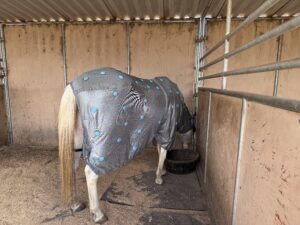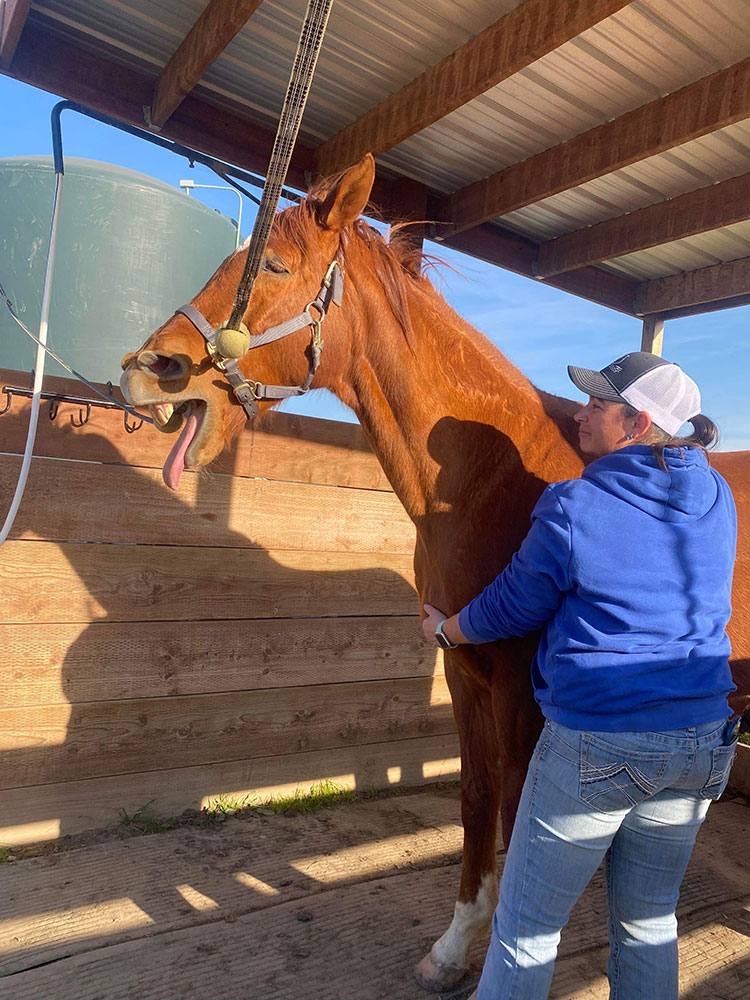Signs Your Horse Needs a Massage
If you’ve ever wondered whether your horse needs a massage, you’re not alone.  Just like people, horses can get stiff, sore, and stressed out—sometimes without us even noticing. The good news is you don’t need to be an equine expert to notice the little signs your horse is sending you. Today I will walk you through all the basics of how to spot when your horse could use a little hands-on help.
Just like people, horses can get stiff, sore, and stressed out—sometimes without us even noticing. The good news is you don’t need to be an equine expert to notice the little signs your horse is sending you. Today I will walk you through all the basics of how to spot when your horse could use a little hands-on help.
Why Would a Horse Need Massage Therapy?
Horses use their bodies constantly, from galloping across pastures to carrying riders, pulling carts, or just playing with their buddies. All that movement can lead to tight muscles, sore spots, or even minor injuries that you might not spot right away.
Equine massage therapy is more than just pampering—it helps relieve tension, improve circulation, increases joint mobility and keeps your horse feeling happy and healthy. Think of it as a tune-up for your horse’s body!
Common Signs Your Horse Might Need a Massage
Not every horse will show the same symptoms, but here are some everyday signs you can look for—no advanced degree needed.
1. Changes in Behavior
· Grumpiness: If your  usually sweet horse is suddenly pinning their ears, swishing their tail, or acting short-tempered, it could be because something hurts.
usually sweet horse is suddenly pinning their ears, swishing their tail, or acting short-tempered, it could be because something hurts.
· Unwillingness to Work: Is your horse refusing to pick up a lead, bucking more often, or just not as interested in doing what you ask? Tight or sore muscles might be holding them back.
· Reluctance to being brushed: If your horse flinches, moves away, or even nips when you brush a certain spot, it’s a clue that area might be sore.
2. Stiffness or Lameness
· Stiff Movements: Does your horse seem to “warm up” slowly? Are they stiff coming out of the stall but loosen up after a while? That might mean they’re carrying muscle tension somewhere.
· Short-Strided or Uneven Gait: If your horse isn’t moving as freely as usual, or you notice a “hitch” in their step, tight muscles could be the culprit.
· Difficulty Bending or Turning: Watch for resistance when riding circles, or if your horse seems to struggle with lateral movements. Stiffness in the neck, back, or shoulders often shows up here first.
3. Physical Signs
· Muscle Spasms or Twitching: Run your hand along your horse’s back or neck. If you notice twitching, flinching, or little spasms, that’s a red flag for muscle trouble.
· Heat or Swelling: Any unusual warmth, puffiness, or swelling along the muscles (not just the legs!) could mean inflammation or soreness. (This may require a vet before you call the massage therapist.)
· Uneven Muscling: If one side of your horse’s body looks more developed than the other, or you see hollows where muscle should be, they might be compensating for discomfort.
 4. Performance Issues
4. Performance Issues
· Decreased Performance: Has your star athlete lost their edge? Slower times, knocking rails, or just not performing up to their usual standard can all be linked to muscle tightness.
· Frequent Tripping or Stumbling: A horse that’s not moving smoothly may trip more often, especially if their shoulders or hindquarters are tight. (Check your horse’s feet first, are the angles where they should be? Consult your farrier if you are worried about your horse’s feet.)
· Problems with Saddling or Bridling: If your horse suddenly objects to tack that usually fits, or tosses their head when bridled, check for muscle soreness under the saddle or along the poll and jaw.
5. Unexplained Attitude Changes
· Sudden Laziness: If your usually energetic horse seems sluggish, their body may need some TLC.
· Overreaction to Touch: Horses that jump or act “ticklish” when you run your hand over certain spots are telling you those areas are sensitive.
· Becoming aggressive: If your horse suddenly becomes aggressive when you brush them or saddle them or even just touch them, they are telling you something hurts.
How to Do a Simple At-Home Check
You don’t have to be a pro to give your horse a basic muscle check. Here’s how:
· Hand Glide: Slowly run your hand over your horse’s neck, shoulders, back, and hindquarters. Pay attention to flinching, twitching, or “hard” spots.
· Watch Their Face: Horses make faces when something hurts—keep an eye out for pinned ears, wide eyes, or wrinkled noses.
· Compare Sides: Does one side feel tighter or lumpier? Make a mental note for your massage therapist or vet.
· Watch them move or video them moving: How are they carrying themselves? Are they moving fluidly?
What Massage Therapy Can Help With
Massage therapy is more than just a “feel-good” fix. It can help with:
· Relieving muscle tension and soreness
· Improving blood flow and recovery time
· Supporting healthy posture and movement
· Reducing the risk of injury
· Helping your horse relax and de-stress
When to Call in the Pros
If you notice any of these signs and they stick around for more than a day or two, or if your horse’s behavior changes dramatically, don’t hesitate to call a certified equine massage therapist—or your vet. Sometimes, what seems like a simple sore muscle can be a clue to a bigger issue.
 Making Massage Part of Your Routine
Making Massage Part of Your Routine
Even if your horse seems fine, regular massage therapy can work wonders for their overall well-being. It’s a great way to bond and a proactive step in keeping your equine friend happy and healthy.
In a Nutshell
You know your horse best. If something feels “off”—whether it’s in the way they move, act, or feel when you’re grooming them—trust your gut. Horses are masters at hiding discomfort, but with a little observation and a gentle touch, you’ll be able to spot when they need a helping hand. And remember, when in doubt, reach out to a professional for guidance!
Here’s to happier, healthier horses—one massage at a time. To book your horse a massage with SLBH Equine Bodywork, head to EquiPro Connect.

